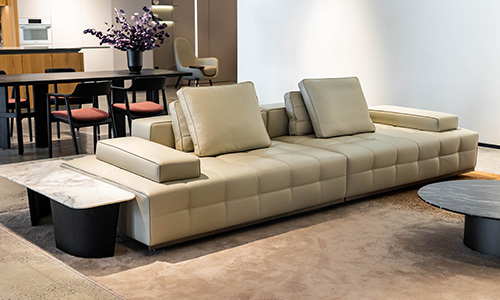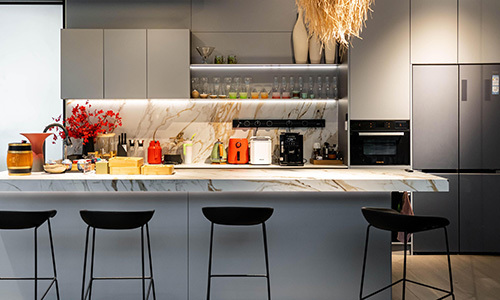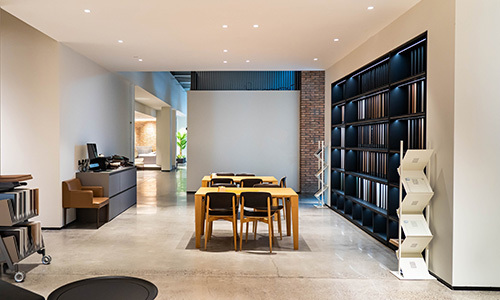Home Furnishing Industry Special Research: Can "Whole-House Customization" Solve the Concentration Problem?
2024-05-22
1.Is the fragmented landscape of the home furnishing and decoration industry an insurmountable problem?
The fragmented and difficult-to-consolidate competitive landscape of the home furnishing and decoration industry has been a long-standing challenge. The home decoration industry is characterized by regional features. According to data from iResearch Consulting and Fastdata, in 2020, the market share of nationwide chain decoration companies was only 10%, and the market share of decoration companies with a scale exceeding 100 million yuan was only 18.6%. Long-tail decoration companies still account for the vast majority. The same is true for home furnishing. According to calculations, the concentration ranking of the three sub-categories is as follows: soft beds and mattresses > sofas > cabinets. In 2020, the CR4 of the higher-concentration mattress category was only 16.9%. Although the concentration of various home furnishing categories has slightly improved in recent years, it remains generally low.
To explore the reasons for the fragmented landscape of the home furnishing and decoration industry, we can examine it from both the supply and demand sides. From the demand side, there are two objective reasons: 1) Home furnishing and decoration are personalized rather than standardized products and services, and are greatly influenced by consumer preferences, with significant differences in choices among different consumers; 2) Low-frequency consumption makes it difficult for brands to gain widespread recognition.
However, aside from the objective reasons on the demand side, from the supply side, the market generally believes that the underlying reasons for the fragmented landscape are the inability of scale effects to manifest due to the non-standard nature of products on the one hand, and the inability to concentrate customer acquisition due to dispersed channels on the other hand. However, we believe that this only determines the upper limit of concentration, not the core factor influencing the concentration trend. The core factor influencing the concentration trend may be whether leading companies can truly solve consumer pain points. According to current research data, consumers still have many sub-categories of pain points in home furnishing and decoration, but there are no companies on the supply side that can truly and widely solve these pain points, and they are even still being ignored. Overall, currently, we believe that consumers' numerous pain points can be divided into old and new pain points. Old pain points include the lack of industry transparency leading to information asymmetry and the low degree of standardization leading to installation errors and non-standard services, while new pain points are more due to the younger generation of consumers, who have pain points such as lack of time, lack of energy, fear of trouble and fear of spending too much money in the home furnishing and decoration process. From the supply side, some pain points (industry transparency, time-consuming, labor-intensive) can indeed be completely solved by companies improving their own capabilities. If a company can take the lead in truly solving pain points or partially solving pain points, its share will inevitably increase. Currently, regardless of whether they are home furnishing companies, traditional home decoration companies, or Internet home decoration companies, they are all launching integrated decoration packages, which to some extent is also based on the consumer's perspective and beginning to solve some of the consumers' pain points. Regardless of whether the current integrated decoration packages can truly solve the pain points, this direction of solving pain points based on the consumer's perspective is bound to be the key to solving the problem of fragmented industry structure in the future. (Report source: Future Think Tank)
2. From multiple perspectives, can "whole-house customization" become a trend?
"Whole-house customization" is a new model launched by home furnishing companies due to their lack of hard decoration capabilities by integrating soft decoration supply chains in the context of home decoration companies, Internet giants, and home furnishing malls all moving toward integrated decoration. To some extent, it is a transitional model for home furnishing companies to move toward integrated decoration, but given that industrialization of home decoration is still difficult to achieve, "whole-house customization" may be the easiest model to implement currently and one that will be difficult to further iterate in the short to medium term. In addition, from the consumer's perspective, with 80s and 90s generation consumers accounting for over 90% of home consumers, "whole-house customization" has begun to consider the needs of the new consumer group and solve some of their consumption pain points. From the perspective of distributors and brand manufacturers, "whole-house customization" undoubtedly meets the core needs of the supply side to expand product categories, increase customer orders, improve market share, and regain traffic entrance in the current situation where natural traffic growth is weak. Overall, the "whole-house customization" model fits the needs of multiple parties and does not have the basis to be iterated in the short to medium term, and its model sustainability is promising.
2.1 Giants are all entering the integrated decoration market, so what is "whole-house customization"?
In recent years, traditional home decoration companies, Internet home decoration companies, and even e-commerce giants and home furnishing malls have all moved toward integrated decoration, while most home furnishing companies have not directly entered the integrated decoration market. Under the trend of integrated decoration, leading home furnishing companies were the first to propose the concept of "whole-house customization." Essentially, "integrated decoration" integrates the entire home decoration industry chain and provides comprehensive home decoration services throughout the process, while "whole-house customization" integrates home furniture, home products, and the entire soft decoration supply chain. Simply put, whole-house customization + basic decoration = integrated decoration. If the ultimate goal of home furnishing companies is also integrated decoration, "whole-house customization" is to some extent a transitional model for home furnishing companies to move toward integrated decoration. However, given that home furnishing companies do not have the capability for hard decoration, and the home decoration industry cannot solve the problems of decoration construction and delivery through industrialization in the short to medium term, "whole-house customization" is not only the easier model to implement currently, but also one that is difficult to be completely iterated in the short to medium term.
2.2 Can "whole-house customization" meet the needs of all parties from multiple perspectives?
2.2.1 Consumer Perspective: "Whole-house customization" has begun to solve some pain points
What changes are happening in furniture consumption needs? With the iteration of consumer groups, the need for one-stop quality assurance is becoming increasingly apparent. The main consumer group of home furnishings in China is gradually shifting to the 80s and 90s generation. According to the Tencent Home White Paper, the combined consumer group accounts for over 92%. Due to the time-consuming and laborious nature of furniture selection and installation, with the increasing proportion of young consumers, the demand for time-saving and labor-saving solutions is also becoming increasingly apparent. The new generation of consumers also pursue brands, quality, and cost-effectiveness, which has led to new pain points in the industry, namely, how to ensure quality and provide cost-effectiveness while helping consumers solve their home furnishing needs in a one-stop manner.
"Whole-house customization" meets consumer needs and solves some consumption pain points: The new consumer group currently has needs for brands, quality, cost-effectiveness, and one-stop solutions. "Whole-house customization" is finding a balance in meeting multiple needs and solving some industry pain points. Although it still cannot solve all the pain points in the home decoration process, it is a major breakthrough at this stage. "Whole-house customization" packages cover most essential home furnishing items, and the package prices and additional items are relatively transparent, which to some extent has significantly improved the overall transparency of the home furnishing industry and can significantly improve consumer purchase trust. It also provides consumers with one-stop solutions through supply chain integration, and the overall solution is also highly cost-effective. The 90s generation of young consumers have relatively low budgets for home decoration and furnishing. The "whole-house customization" package integrates customized and finished furniture sales, showing high cost-effectiveness, such as the 29,800 yuan package from Oppein and the 39,800 yuan package from Sophia. Buying these items separately at retail prices would far exceed the package price.
Overall, from the consumer's perspective, "whole-house customization" has indeed begun to solve some consumer pain points, and the direction of better meeting consumer needs is correct. In the short term, home furnishing and decoration companies are unlikely to make a full and perfect transition to integrated decoration, so the continued trend of "whole-house customization" is worth expecting.
2.2.2 Brand Perspective: "Whole-house customization" meets the needs of expanding product categories and is expected to regain the traffic entrance
From the perspective of brand owners: (1) Expanding product categories and increasing market share have become key to growth. Based on the macroeconomic situation, China's overall new housing sales are slowing down, and first and second-tier cities are gradually entering the era of existing housing. However, assuming a 15-year renovation cycle for new houses, new house renovations are still expected to be the main source of demand in the renovation market in the short term. It is estimated that the demand for existing house renovations will only account for 33% of the total demand by 2025. Furthermore, furniture is more troublesome to disassemble and reassemble, and it will more likely match the renovation cycle. The downward pressure on customer traffic in the home furnishing industry has already emerged. Therefore, brand owners' demand for expanding product categories and increasing market share is becoming increasingly strong, and this will be the key driver of future brand growth.
(2) Whole-house customization is expected to help brand owners regain their ability to capture traffic, strengthen channel control, and stabilize pricing power. The reason why whole-house renovation companies have gradually eroded the traffic of home furnishing dealers over the years is mainly because whole-house renovation companies can essentially contact consumers earlier. As consumers are becoming younger, the demand for one-stop solutions is becoming increasingly stronger. Whole-house renovation companies can provide consumers with complete solutions and more cost-effective prices, inevitably diverting more and more traffic from home furnishing dealers. However, for customized home furnishing brands, their channel control is relatively weak, and the cooperation stickiness with decoration companies is not strong. If this continues, the pricing power of brand owners may be affected. The launch of "whole-house customization," while not directly involved in whole-house renovation, can already meet the basic needs of many consumers in the high-end housing market. It is expected to allow brand owners to regain their ability to capture traffic to some extent, and this model allows brand owners to still control channel resources and strengthen their brand pricing power.
Keywords:
Related News
How should I arrange my living room furniture to maximize the space?
2024-05-22
Advanced gray + smoke pink tone space design to create a sultry light mature style!
2024-05-22
2024-05-22











